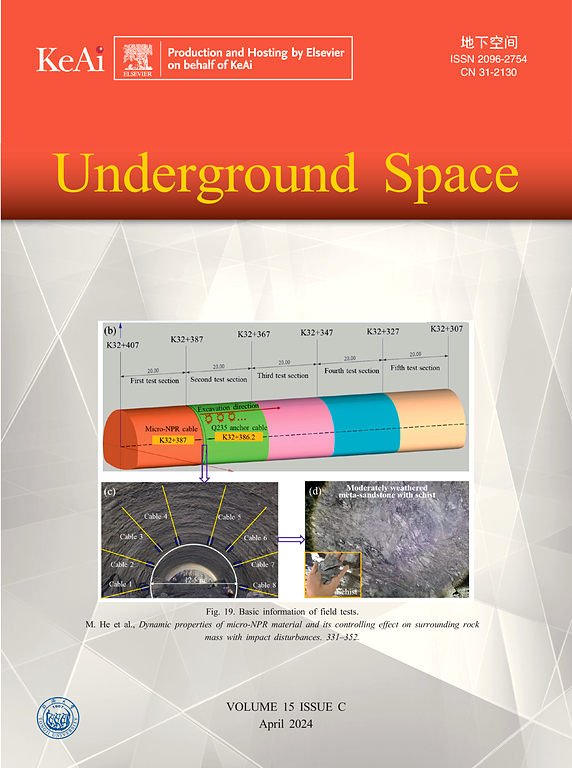Test and field application of fracture evolution of large-span tunnel under NPR bolt compensation support system
IF 8.3
1区 工程技术
Q1 ENGINEERING, CIVIL
引用次数: 0
Abstract
Shallow-buried large-span tunnels may bend or collapse owing to loads, and their surface structures present considerable safety issues. At Huashanyilu station on Qingdao Metro Line 6 in China, theoretical studies and interior model tests were conducted to effectively increase the bearing capacity of the tunnel. The anchoring bearing mechanism of the high prestress compensating support system was revealed, and the system was built using a negative Poisson’s ratio (NPR) bolt at its core. We compared and analyzed the fracture evolution characteristics of the compensating and conventional support systems under various loads. The results showed that the compensating support system effectively increased the support strength and residual safety factor of the bearing arch, whereas the use of a high-prestress NPR anchor reduced the early deformation of the surrounding rock. The coupling failure modes of the arch tension extrusion failure and arch foot shear fracture occurred when the tunnel surrounding the rock was overloaded. The compensatory support system produces a bearing arch that is extremely resistant to external loads with minimal deformation of the tunnel surface and arch frame, excellent surrounding rock integrity, and a low stress rate. The radial and tangential peak stresses exceeded those of the passive support system, and the structural block fell when it became unstable. The maximum displacement of the arch stays constant at −5.7 mm after tunnel excavation. NPR bolts have remarkable applications in this field. The conclusions of this study have a significant impact on the regulation of the stability of the surrounding rock in large-span tunnels.
NPR 螺栓补偿支撑系统下大跨度隧道断裂演化试验与现场应用
浅埋大跨度隧道在荷载作用下可能发生弯曲或坍塌,其表面结构存在较大的安全问题。在中国青岛地铁6号线华山驿路站进行了理论研究和室内模型试验,以有效提高隧道的承载能力。揭示了高预应力补偿支护体系的锚固承载机理,并采用负泊松比锚杆构建了高预应力补偿支护体系。对比分析了补偿支护系统和常规支护系统在不同载荷作用下的断裂演化特征。结果表明:补偿支护系统有效提高了承载拱的支护强度和残余安全系数,而采用高预应力NPR锚杆则降低了围岩的早期变形;巷道围岩超载时,拱张挤破坏与拱脚剪切破坏的耦合破坏模式。补偿支撑系统产生的承重拱具有极强的抗外部载荷能力,隧道表面和拱架变形最小,围岩完整性好,应力率低。径向和切向峰值应力均超过被动支护体系峰值应力,结构块体失稳时发生垮塌。隧道开挖后拱的最大位移保持不变,为- 5.7 mm。NPR螺栓在这一领域有着显著的应用。研究结论对大跨度隧道围岩稳定性的调控具有重要意义。
本文章由计算机程序翻译,如有差异,请以英文原文为准。
求助全文
约1分钟内获得全文
求助全文
来源期刊

Underground Space
ENGINEERING, CIVIL-
CiteScore
10.20
自引率
14.10%
发文量
71
审稿时长
63 days
期刊介绍:
Underground Space is an open access international journal without article processing charges (APC) committed to serving as a scientific forum for researchers and practitioners in the field of underground engineering. The journal welcomes manuscripts that deal with original theories, methods, technologies, and important applications throughout the life-cycle of underground projects, including planning, design, operation and maintenance, disaster prevention, and demolition. The journal is particularly interested in manuscripts related to the latest development of smart underground engineering from the perspectives of resilience, resources saving, environmental friendliness, humanity, and artificial intelligence. The manuscripts are expected to have significant innovation and potential impact in the field of underground engineering, and should have clear association with or application in underground projects.
 求助内容:
求助内容: 应助结果提醒方式:
应助结果提醒方式:


